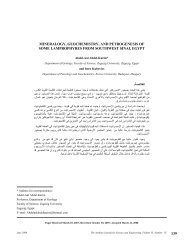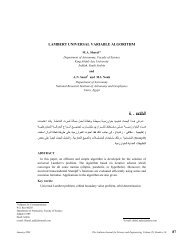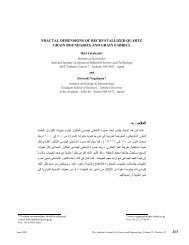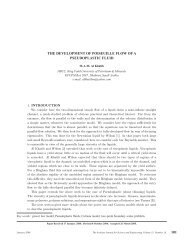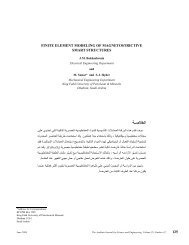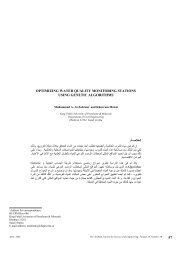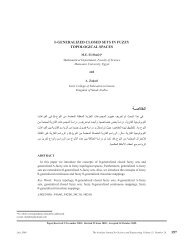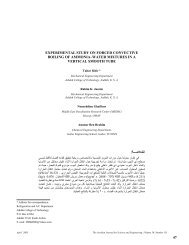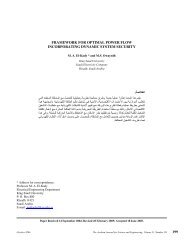HYDRODESULFURIZATION OF THIOPHENE OVER BIMETALLIC ...
HYDRODESULFURIZATION OF THIOPHENE OVER BIMETALLIC ...
HYDRODESULFURIZATION OF THIOPHENE OVER BIMETALLIC ...
You also want an ePaper? Increase the reach of your titles
YUMPU automatically turns print PDFs into web optimized ePapers that Google loves.
62<br />
Hamid A. Al-Megren<br />
Figure 6 shows the ratios of butane and butenes (C4/C4 = ), which are produced from HDS of thiophene reaction.<br />
The OMXC catalyst yielded the highest content of olefins, as compared to the IMPR catalyst. Products distribution<br />
data provide some insight into the possible pathway of thiophene desulfurization, which is difficult to extract from<br />
similar catalysts in which products are substantially altered by high rates of hydrogenation and isomerization<br />
reactions.<br />
More important are the differences between the three catalysts (IMPR, MECH, and OMXC) when we consider<br />
the product distributions. GC analysis showed the formation of mainly C4 and C4 = fractions, but it has not showed<br />
the formation of tetrahydrothiophene and butadiene. However many authors have argued for the preferential direct<br />
desulfurization route, by the absence of tetrahydrothiophene [50].<br />
Therefore our result shows that the pathway of reaction is the direct hydrodesulfurization route with successive<br />
hydrogenation, as shown in Scheme 1.<br />
S<br />
HDS<br />
HD<br />
S<br />
HD<br />
HDS<br />
HD<br />
HDS<br />
Scheme 1<br />
With the three catalysts, the ratio of C4 to C4 = is around 2.5.<br />
This suggests butane generation by hydrogenation of C4 compounds. These compounds are produced through the<br />
hydrogenolysis of thiophene and probably from β-H elimination from intermediate hydrogenated thiophenes [55].<br />
Table 2 shows the chemical analysis for the three samples analyzed before and after HDS reaction for more than<br />
seven hours. The sulfur content for the three samples increased after the HDS reaction. This sulfur content increase<br />
could be attributed to formation of sulfur species during the HDS reaction by the oxide phases that remain in the<br />
sample. The sample prepared by OMXC method shows more chemical stability compared to the samples prepared<br />
by other methods. The reaction rate was calculated for the HDS reaction over the three different catalysts. The<br />
catalyst prepared using OMXC method a shows higher reaction rate than IMPR and MECH.<br />
Table 2. Chemical Analysis for NiMoS Catalyst before and after HDS of Thiophene Reaction at 350ºC and<br />
Atmospheric Pressure<br />
Methods Before Reaction % After Reaction % Reaction rate<br />
Al Mo Ni S Al Mo Ni S μmol (g min) -1<br />
IMPR 47.28 24.49 7.41 20.81 41.61 24.36 5.61 28.42 58.16<br />
OMXC 46.63 18.60 9.68 25.10 42.46 19.31 9.50 28.74 73.80<br />
MECH 45.34 18.64 11.35 24.67 36.52 19.74 12.45 31.29 26.05<br />
The structure stability after the HDS reaction for the three samples was analyzed by X-ray and Raman<br />
spectroscopy. The X-ray patterns (Figure 7) for all the samples show higher structure stability after the HDS<br />
reaction. The remaining peaks of MoO3 over the MECH sample after sulfurization reaction were converted to the<br />
sulfide phase.<br />
Raman spectra for the three samples after HDS reaction are shown in Figure 8. It is shown that all bands for<br />
Mo=O and Mo–O–Mo vibrations at 995 cm –1 and 830 cm –1 on the IMPR sample are eliminated during the HDS<br />
reaction. There is also a reduction in band 965 cm –1 for the MECH sample.<br />
January 2009 The Arabian Journal for Science and Engineering, Volume 34, Number 1A<br />
HD



